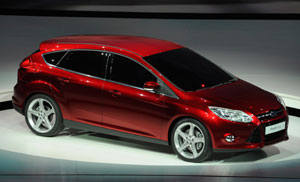
DETROIT – The upcoming ’12 Ford Focus is superior to the model offered in North America today in every regard, representing “a paradigm shift” in the auto maker’s C-car offering, a top engineer with the auto maker says.
“It’s going to be best in class vs. C-segment and C/D-segment competitors,” Jim Hughes, chief nameplate engineer in North America for the next-generation Ford Focus, tells Ward’s at the North American International Auto Show here.
“It’s better (than the current model) in every aspect, including craftsmanship, fuel economy, design quality and technology – all the key aspects the customer is looking for.”
The development of the upcoming Focus, due to begin production later this year, with sales launching in early 2011, represents a concerted effort that drew on the expertise of Ford’s global operations.
The epicenter was the auto maker’s vehicle operations in Merkenich, near Cologne, Germany, Hughes says. “The (Focus) was primarily designed, and even the studio work was done, out of that development center.”
Creating a global car with minimal changes for the various markets was a formidable task, one that forced Ford engineers, designers and product planners to rethink the way vehicles are developed.
Aligning a supply base that would allow for the greatest degree of parts commonality worldwide was one of the main hurdles, Hughes says, noting the new Focus will be nearly identical in all markets, with 80% shared parts.
“And if you include the modestly modified parts, it’s almost 90% commonality across the globe,” he says. “Logistically, globally is more challenging than doing this regionally. There’s no doubt about that. We only deviate where federal requirements dictate.”
Hughes cites headlamps as one example. “They have to be different in different regions.”
Despite the challenges, the Focus team has leveraged a network of suppliers able to deliver parts to all production sites, which initially will include plants in Saarlouis, Germany; Wayne, MI; and Chongqing, China.

Ford executives decline to reveal whether the new Focus will share any parts with the current North American version, but it is unlikely the two cars have much in common, including the platforms on which they sit.
When the original Focus launched in 1999 as a ’00 model, both the North American and European versions were based on the auto maker’s C170 platform.
In 2004, Europe launched a redesigned Focus underpinned by a new C1 architecture, while North American product planners in an effort to keep costs down retained the C170 platform.
While the North American Focus remains a top-seller for Ford, the European offering is considered far superior in handling and performance.
But the playing field will be evened next year, as the ’12 Focus will ride on a tuned version of the C1 in all markets. The platform is remarkably versatile and eventually will support up to 10 unique models, Ford says.
Hughes notes the scalable architecture already underpins the Transit Connect small commercial van. “So it provides more ease of flexibility for us and speed to market. When we have one common platform for various vehicle lines, we can have all the goodness of a very robust platform and migrate it to many different ‘top hats.’”
The C1 is scheduled to replace the C170 and two other global C-segment platforms, which will lead to cost savings due to the economies of scale, allowing Ford to turn a profit on small cars even in the U.S.
Although the auto maker is saving money under its “One Ford” initiative, which calls for sharing global resources, it is spending additional funds where needed, such as new engines.
Gone is the aging 140-hp 2.0L Duratec DOHC inline 4-cyl. that powers the current Focus. In its place will be a new 2.0L direct-injected I-4 with twin independent variable camshaft timing that is expected to generate at least 155 hp while also providing improved fuel economy.
Ford says a version of its turbocharged EcoBoost D1engine eventually will be offered on the Focus.
The updated 2.0L engine will be mated to either a 6-speed manual or a new 6-speed dual-clutch automatic transmission. Dubbed “PowerShift,” the new line of small-car automatic transmissions can reduce fuel consumption up to 9%, the company says.
Ford’s PowerShift transmissions, developed with German supplier Getrag GmbH & Cie KG, essentially consists of two manual transmissions working in parallel, each with an independent clutch unit.
In comparison, the current North American Focus is available with either a 5-speed manual or 4-speed automatic transmission. Ford says advanced 6-speed transmissions such as PowerShift will be offered on nearly its entire vehicle lineup by 2013.
Accenting the new powertrain are a number of technologies designed to enhance driving performance, including an updated version of Ford’s “control blade” multi-link rear suspension and McPherson-type struts up front.
The control-blade setup, originally developed by former Ford engineer Richard Parry-Jones, combines elements of a trailing arm and a double wishbone suspension.
In an effort to reduce understeer, a problem associated with front-wheel-drive vehicles, Ford is equipping the ’12 Focus with its Dynamic Cornering Control torque-vectoring system, which transfers power between the two drive wheels.
Hughes says lessons learned from the Focus program will prove invaluable. “It’s going to help us accelerate the development of global cars in the future.”



